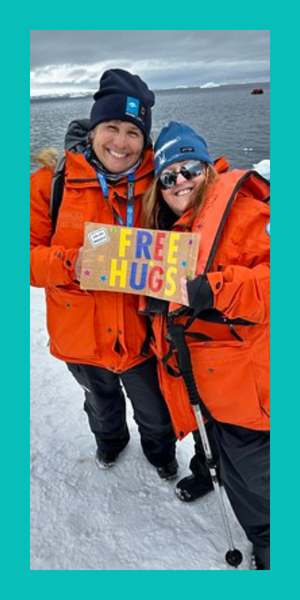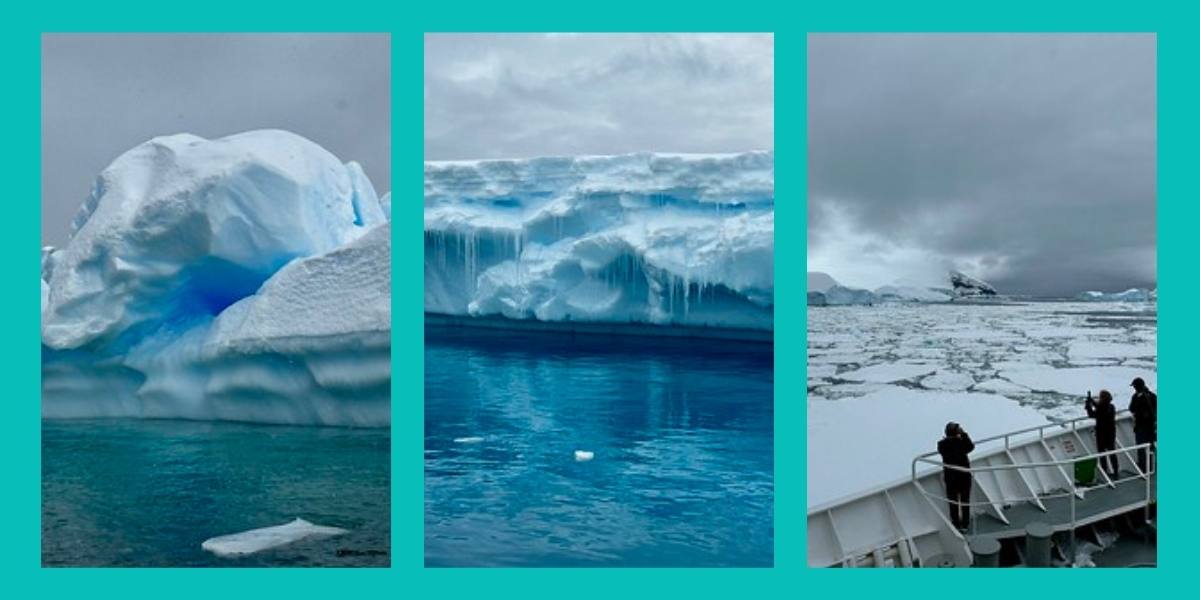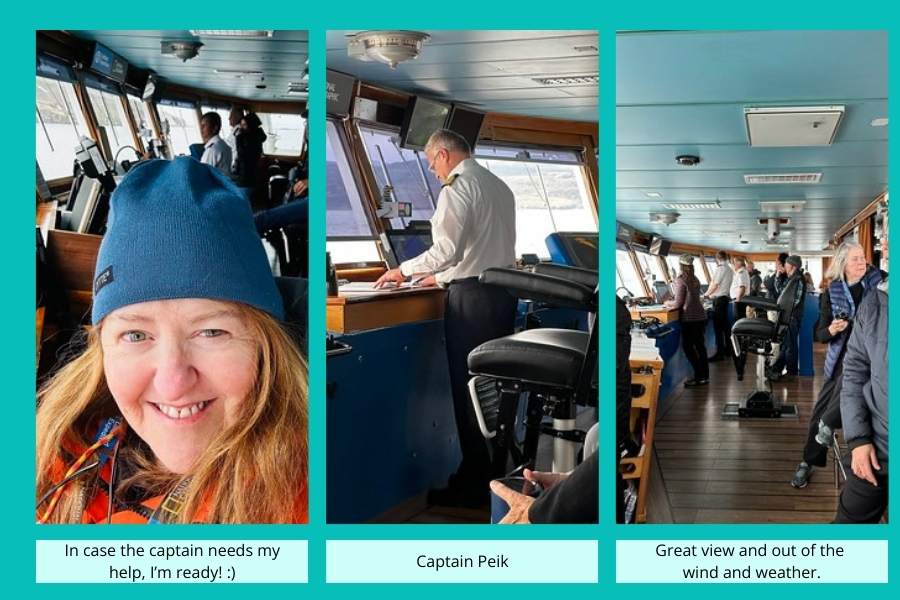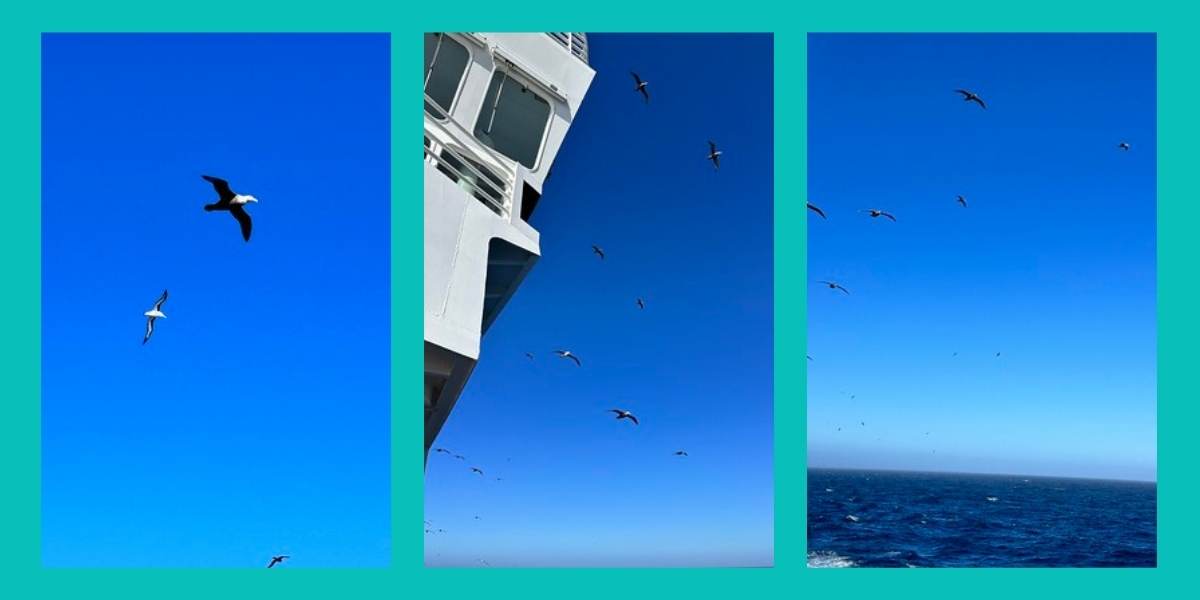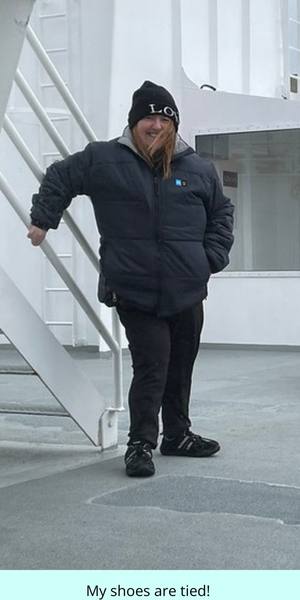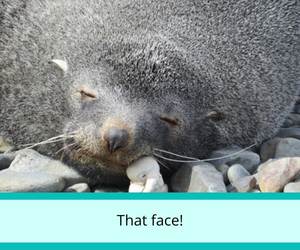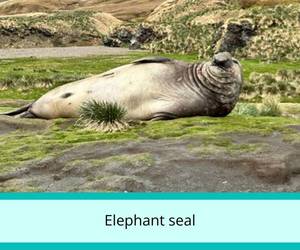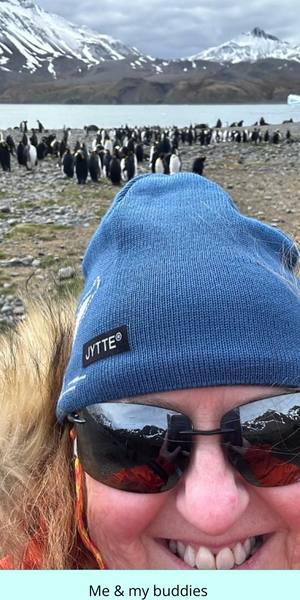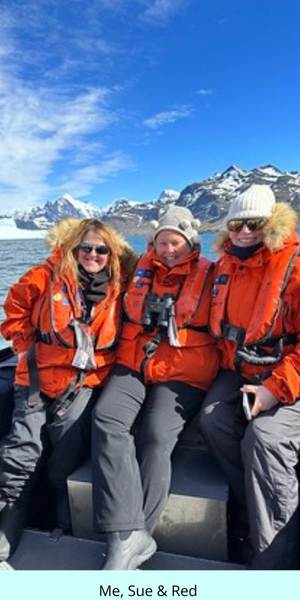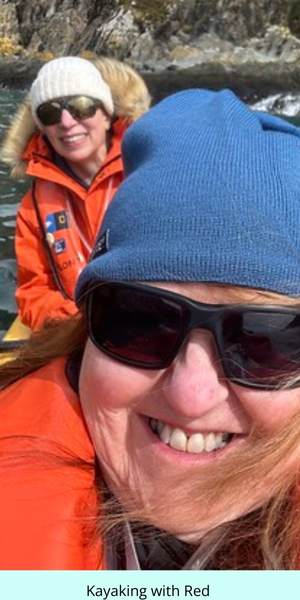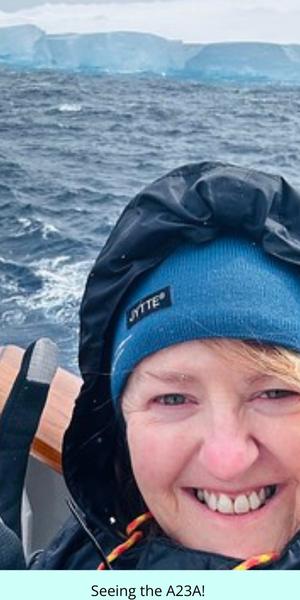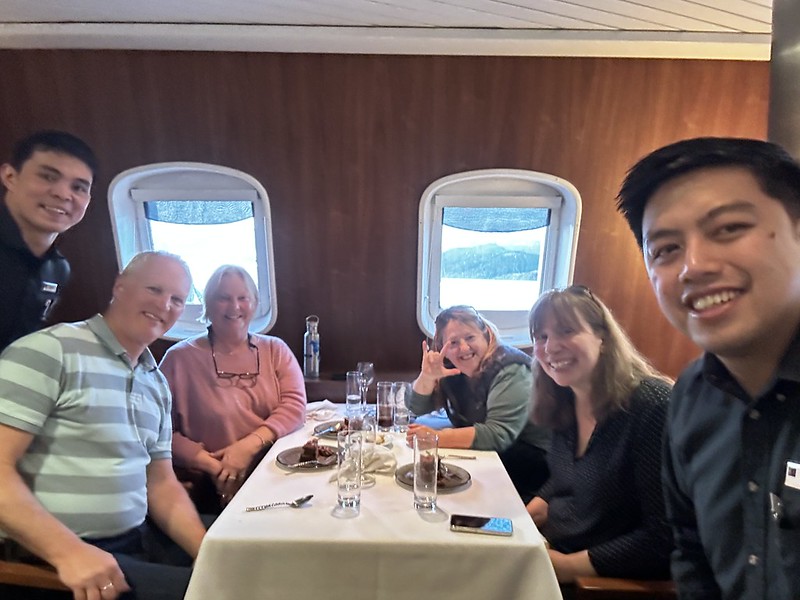Prologue
It’s been over nine months since I returned from an incredible three-week cruise across the Falkland Islands, South Georgia Islands, and Antarctica! While I started this blog shortly after my return, I’m only now completing it. It’s been a joy to relive the adventure, and I want to give a big shout-out to Jen Reiter and Sandy Reed, both teachers on the trip who blogged daily. Their blog posts, along with my Facebook posts, helped me recall names and wildlife we encountered, and I’m sure I still missed things. Meeting both enhanced the experience, and I’m grateful to have also brought home their friendships. I highly recommend checking out their blogs; as educators, they provide deeper insights into our experiences.
The Journey Begins
How do you capture the indescribable essence of an experience when words fall short? You find yourself recycling them, fully aware that no single word can aptly convey the profound depth of the encounter. Whether it be “amazing,” “WOW,” “awesome,” “breathtaking,” “beautiful,” “gorgeous,” or “spectacular,” the familiar words seem insufficient. In the paragraphs below, I will attempt to articulate the realization of a cherished dream—my expedition to Antarctica. Join me on this journey of words and pictures as I try to encapsulate the magic.
As the days unfolded, each surpassed its predecessor in beauty and adventure. As our expedition approached its conclusion, fellow explorers engaged in reflection, pondering their favorite moments. While many struggled to pinpoint a singular highlight, I had a crystal-clear answer. On November 24th, I had the privilege of offering HUGS—in Antarctica! Having organized Global Free Hug events since 2008, I had dreamt of sharing hugs on every continent, and Antarctica had remained elusive until that moment—when I shared hugs on the seventh continent.
While the entire trip was mind-blowing, here are my top five experiences:
1. Offering hugs in Antarctica
2. Living on a boat for nearly three weeks
3. The fantastic people I met and heard about their previous adventures.
4. The ICE.
5. The wildlife
One – Free Hugs in Antarctica
Since 2008, I’ve been a passionate advocate of free hugs. That same year, I initiated Global Free Hugs, an annual event uniting people worldwide in offering hugs within their communities, fostering connections in our beautiful yet messy world. Across six continents, spanning 47 countries and 36 US states, I’ve witnessed the power of hugs to convey a simple yet profound message: that every individual matters.
However, Antarctica had remained untouched by this global hug movement until our expedition. Despite previous attempts to connect on the icy continent, I could not connect with a researcher on the continent, and its winter conditions during the May Hugs weekend had posed obstacles. I was nervous and excited about being able to offer hugs on this trip, and I was thrilled to discover many of the explorers and crew on board were eager to assist in making my dream a reality. If you’re inspired to join the global hug team, CLICK HERE and be part of spreading kindness and connection across the globe.
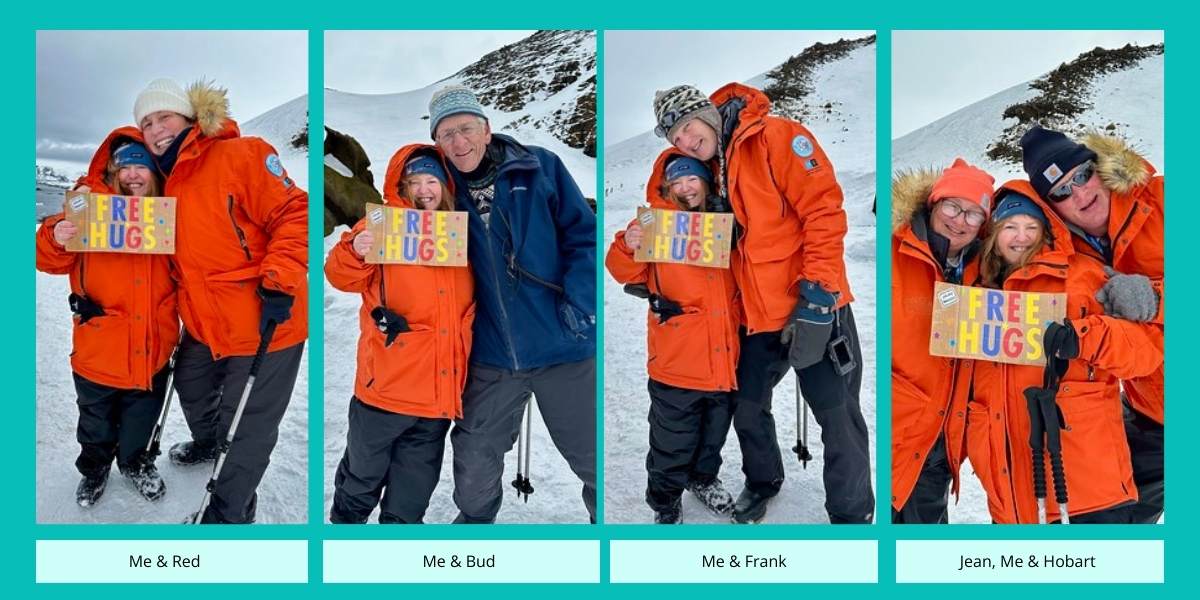
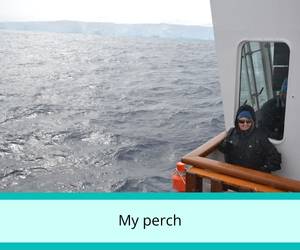
Two – The LOVE of Water
A profound LOVE for the water is no secret for those acquainted with my passions. Living on the water has long held a spot on my bucket list, and for three blissful weeks, that dream materialized. While other explorers faced sea sickness, I thankfully don’t have an issue with that, and I found being rocked to sleep each night magical.
Three – My Fellow Explorers
Although I didn’t engage with each of the 120 fellow explorers, our conversations were captivating. Their lives and travels opened my heart to even bigger possibilities for what is out there to be lived. Near the end of the cruise, the group was asked how many had been to Antarctica before, and I would say 20% raised their hands that they had! Among the diverse individuals, I met a NASA scientist, a retired racecar driver, an Iditarod staffer, educators, social workers, environmentalists, and various scientists, all who LOVED to travel, explore, and learn. Notably, two teachers, Jen and Sandy, aboard shared this adventure with their students—3rd-grade boys in Baltimore and junior high students in Ohio. Amidst these connections, endearing friendships were created, and I look forward to deepening the connections and future travels. I learned to play cribbage with Sue and Frank, new friends from Foxboro, MA.
While not all are pictured in the blog, my album has many more pictures. These are such fun people!
From the Captain to the cleaning crew, every team member was kind, fun, and incredibly helpful. Photographers Susan and Eric were always available, offering expert assistance with capturing the perfect shot. The historians and naturalists enriched the journey, providing fascinating insights into the places we visited. Together, they all contributed to making the experience unforgettable.

While the Lindblad and Nat Geo naturalists were terrific, we also traveled with an award-winning photographer and drone pilot, Martin Gregus Jr., and his father. They both lent their expertise to the photographers on board to capture the best pictures and shared their photos with us at the end of the journey. Martin Jr. also received permission to fly his drone and got amazing footage of the Explorer sailing through the ice. Check out his fantastic work on his Instagram page.
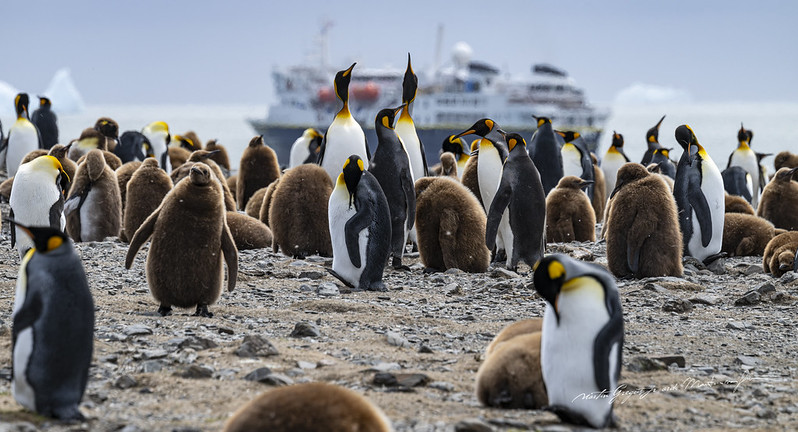
Four – The Majestic Ice
The ICE! Describing the feeling of being amidst ice is a challenge—it’s an experience that transcends the ordinary. As we navigated around the South Georgia Island, colossal icebergs began to grace our journey. Our expedition leader, Bud Lehnhausen, noted that this early encounter with icebergs was outside the usual timeline. For a detailed account of our daily experiences with these frozen masterpieces, refer to the report below. The allure and impact of the ice defy simple explanation, as you felt like you were in another world.
Five: The Wildlife
Penguins, seals, whales, and birds—oh, my!
Below is a list of the wildlife we encountered. I am sure I missed many bird species, yet they were magnificent. You can check out my Daily Log for more information and pictures of what we saw. They say you will smell the wildlife before you see it, and that sure is true! The travel season is October thru March, so I was there early in the season. I’m not sure I could handle the aroma in March. 🙂
Birds: Black-Brown Albatross, Cape Petrel, Cormorants, Giant Petrel, Light-Mantled Albatross, Thin-Billed Prions, Royal Albatross, Sooty Albatross, Wandering Albatross, and many more that I missed the names of.
Dolphins: Commersons
Penguins: Adelie, Chinstrap, Emporer, Gentoo, King, Macaroni, Rockhopper
Seals: Crab, Elephant, Fur, Leopard, Weddell
Sea Lions
Whales: Blue, Fin, Humpback, Orcas
And so much more!
It was challenging to capture almost three weeks in which each day surpassed the one before. This journey was a once-in-a-lifetime experience, yet I hesitate to confine my visits to this breathtaking area to just a single occurrence. Let me highlight a few more noteworthy points, and if interested, you can delve into the detailed daily log below.
Sunlight
I was looking forward to 24 hours of sun. While there wasn’t 24 hours of sunlight, it was rarely dark. It seemed to be more like twilight between sunset and sunrise. However, I saw the Milky Way and the Northern Cross early on the trip.

The Endurance – Shackleton
My friend, Red, had read the book ‘The Endurance’ years ago and has since read it a few times. It’s an accurate tale about the incredible voyage of Ernest Shackleton and his crew of 27 men who set sail for Antarctica on November 5th, 1914. The ice crushed their boat, and they set foot to find help.
Six of the 27 men set out to find help, and after a harrowing experience and 18 months, they found their way to a whaling station. Then, they returned to get the men left behind, and ALL the crew survived. An interesting side note: the wreckage was discovered in March of 2022 and is in excellent condition.
This adventure was covered in several talks, and we visited Shackleton’s grave on South Georgia Island to pay tribute. Many of my fellow expeditionists were familiar with Shackleton, and just like my friend, that was the main reason they were there.
Creating Memories
While I hadn’t read the book, I purchased it onboard and got those on this incredible adventure with me to sign it. It is such a fun souvenir to revisit.
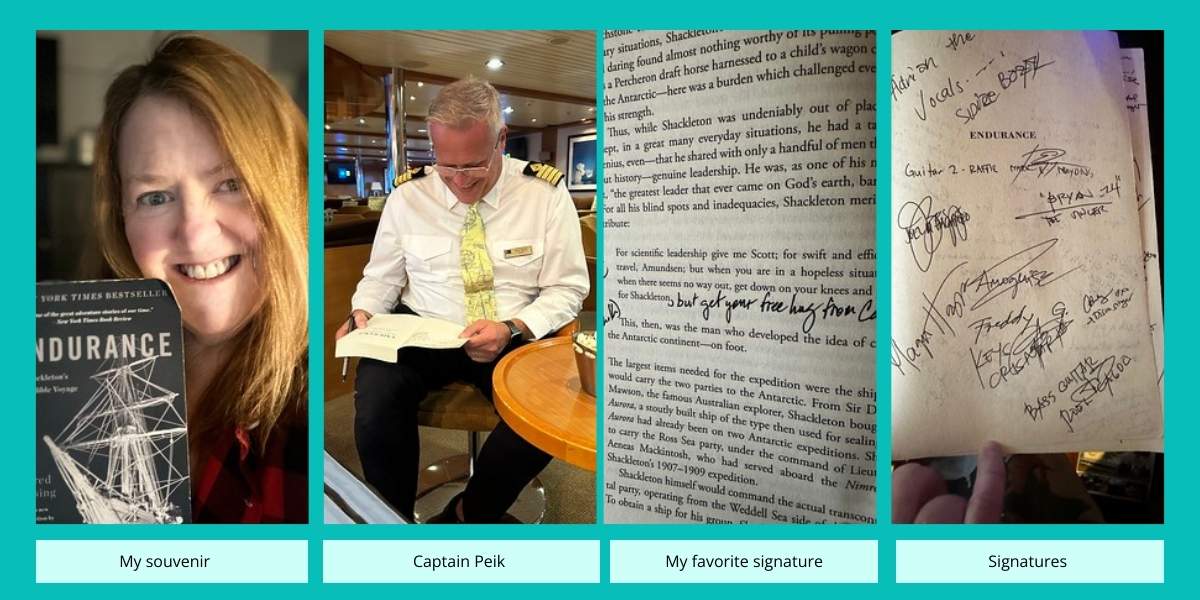
Daily Schedule
We started with a morning adventure. Every day, we spent time near the land, followed by lunch back at the ship. Then, we’d head out for an afternoon adventure, enjoy afternoon tea, and gather for cocktail hour to chat about the day’s activities before dinner. We would either go to shore, kayak, or do a Zodiac tour. On sea days, there were various talks from the naturalists, and we had plenty of time to watch the ice and wildlife.
The bridge was always open for us to visit anytime we wanted. Many of us spent much time there, enjoying the crew’s warm welcome and the stunning views.
Daily Log
November 7 (Day 1): A Trip of a Lifetime Begins!
The journey began with a flight from O’Hare to Atlanta, followed by an overnight flight to Buenos Aires. Despite a slight delay in Atlanta, the trip proceeded smoothly. Each moment in the air marked the beginning of an adventure filled with promise and excitement, a prelude to the extraordinary experiences awaiting Buenos Aires.
November 8 (Day 2): Hello Buenos Aires!
I made it to Buenos Aires and met up with my friend Red and the others traveling with us on the expedition. After checking in at the Alvear Art Hotel, we had a hospitality lunch to meet our fellow expeditioners. Then, we took a bus tour that stopped at Recoleta Cemetery, a place of stunning architecture and the final resting place of notable figures like Eva Peron. We also toured El Zanjon de Granados, a restored labyrinth of urban archaeology on the site of Buenos Aires’ first settlement in 1536. We returned to the hotel for a welcome reception, dinner, and an early night, preparing for a 3:30 am wake-up call to start our journey to Ushuaia. By the way, the excursion marketing materials ignored a 3:30 am wake-up call. 😉
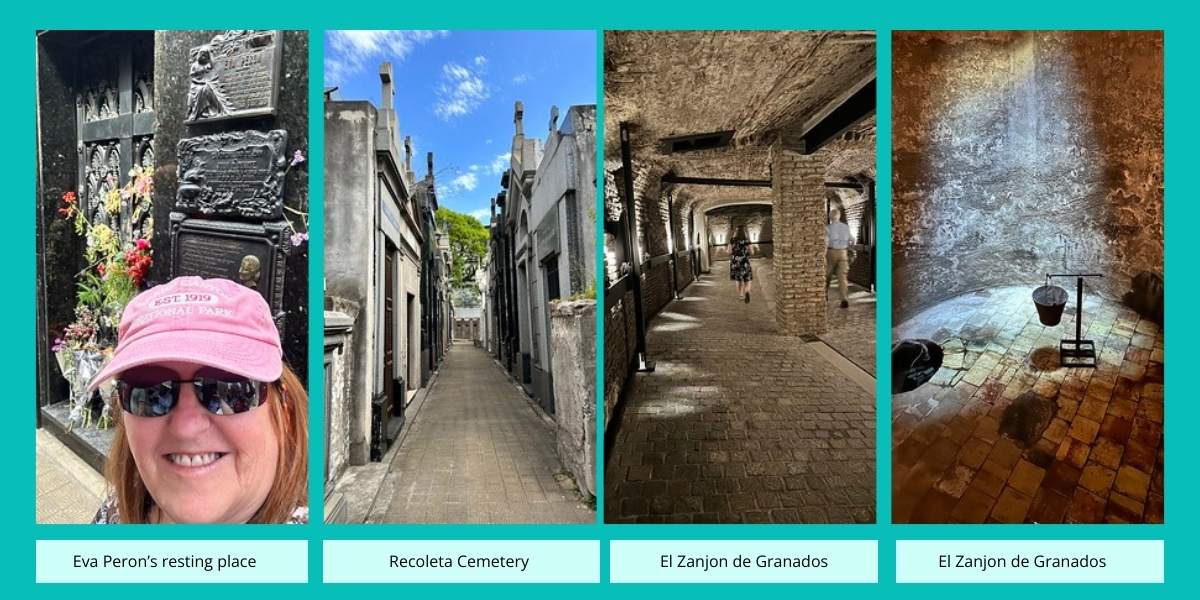
November 9 (Day 3): Hello, Ushuaia and Lindblad Explorer (home sweet home)!
Three AM comes early, but the excitement of the journey ahead matters more. After a quick breakfast, we took a bus ride to the airport for a chartered three-hour flight to Ushuaia, the southernmost city in the world, nicknamed “the end of the world.” As we neared the airport, it felt like landing on a postcard, with majestic snow-covered mountains greeting us. We boarded a bus for a tour through Tierra del Fuego National Park, the border of Chile and Argentina.
Next, we boarded a catamaran for lunch and sailed through the Beagle Channel, a stunning strait between Chile and Argentina. The beautiful sail, full of wildlife, ended at the dock where we boarded the National Geographic Explorer—our home for the next three weeks! Did I mention that I love being on a boat?
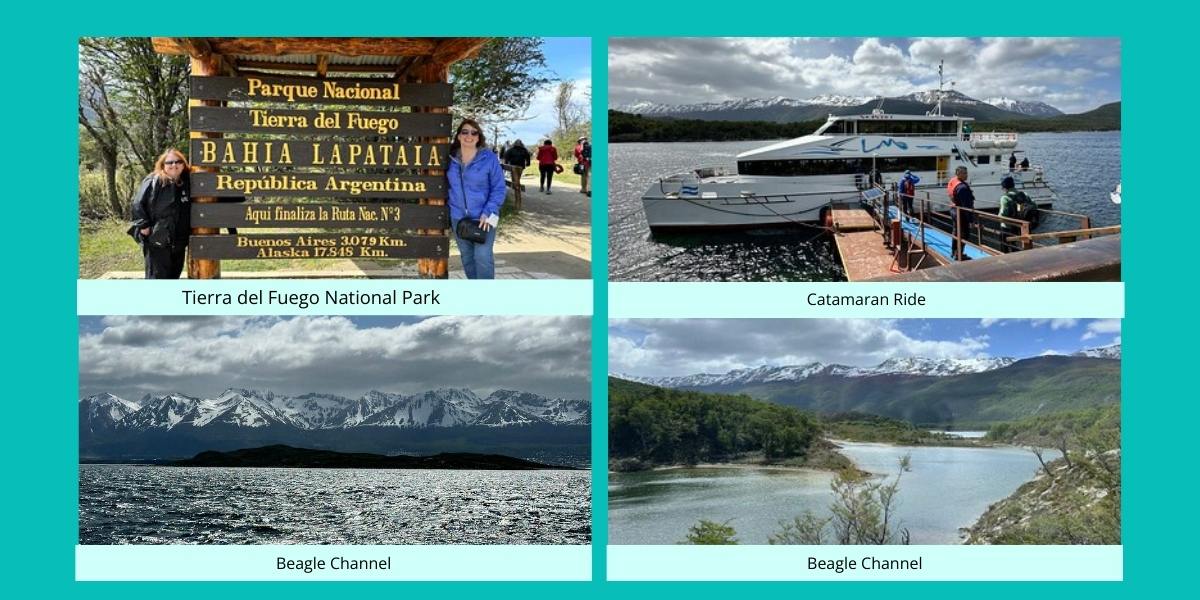
We had time to explore the ship, do a lifeboat drill, and enjoy a welcome dinner before setting off on our adventure.
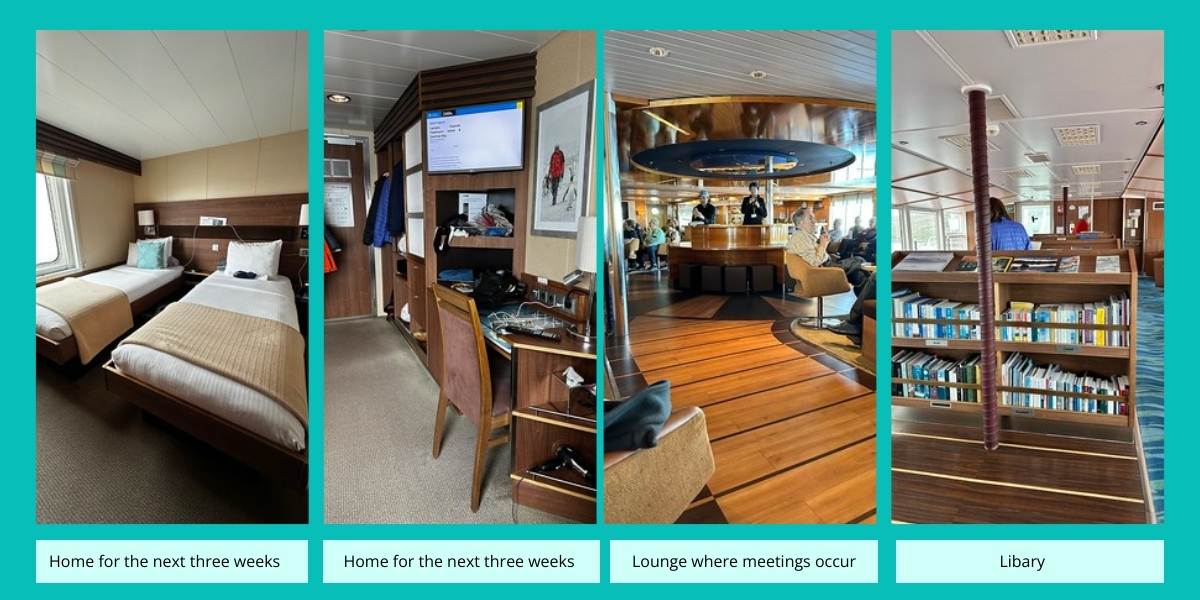
Wildlife spotting (9th): albatross, cormorants, geese, sea lions
November 10 (Day 4): Headed to the Falkland Islands on the Scotia Sea.
Today was a beautiful day at sea. We met the staff and crew, did a lifeboat drill, and learned about the IAATO, a group dedicated to responsible travel to Antarctica and preserving the area and biosecurity. While it was a lovely day, many explorers were seasick from the rocking and rolling. As a longtime sailor, I’m grateful seasickness isn’t an issue, but some of my new friends struggled.
The crew’s care for the environment and wildlife was refreshing. Although it never got fully dark, we closed all the blinds on the ship at night to prevent seabirds from flying into the lit windows.
Wildlife spotting (10th): albatross, petrels
November 11 (Day 5): Hello, New Island!
Land ho! Our first Zodiac ride to New Island. Dress in layers, grab your gear, and head to the mudroom to prepare. Ensure your outer clothing and boots are clean, then hop on a Zodiac to drop you off onshore. Shore landings varied from easy to challenging, depending on weather conditions. The island is grassy and vast, with no snow but beautiful yellow flowering bushes.
We took a 30-minute walk to find a colony of black-browed albatross and our first sighting—the rockhopper penguin! I am in LOVE! We were instructed to keep a certain distance from the wildlife, but they often came close to us. The penguins didn’t seem to care that we were there, which was incredible!
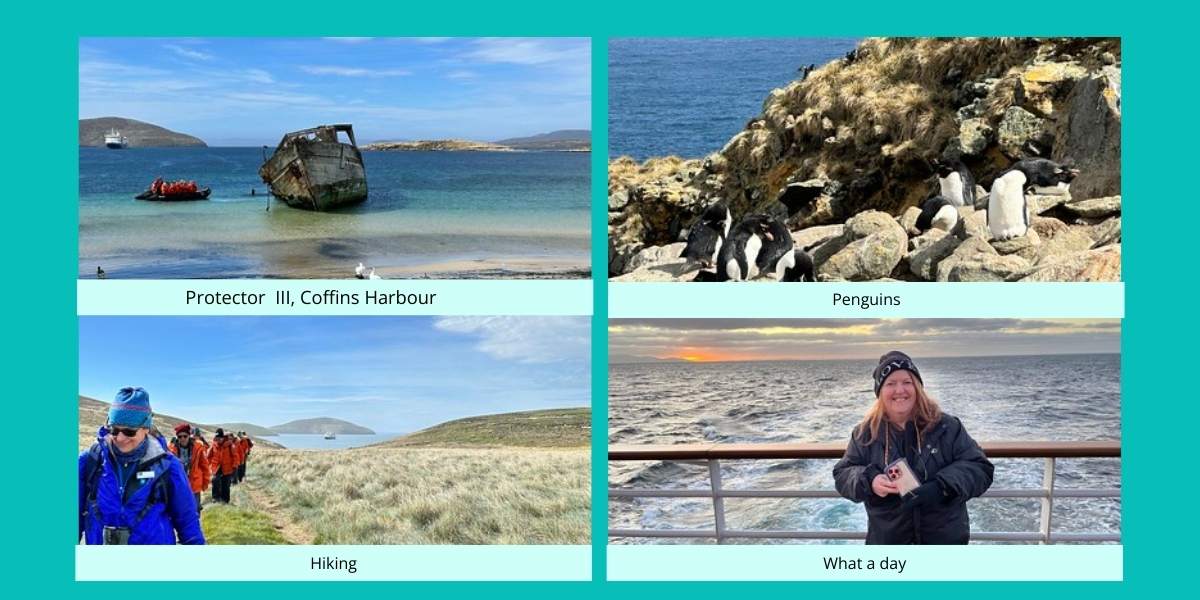
Wildlife spotting (11th): albatross, rockhopper penguins
November 12 (Day 6): Hello, West Point Island.
Another day, another adventure. Weather conditions prevented us from going ashore at our first location, so the captain shifted plans. The crew always had plans A, B, and C ready, following the weather patterns closely. Carcass Island was too windy, and the seas at Saunders Island were too rough, so we moved on to our afternoon location—West Point Island.
We had a mile walk against the wind to see rockhopper penguins. Hiking isn’t my thing, especially on uneven terrain, in waterproof boots, and wearing too many layers to count. So, I hopped on a Land Rover for a bumpy ride. It was fun and made me rethink my frustrations with Chicago potholes. 🙂
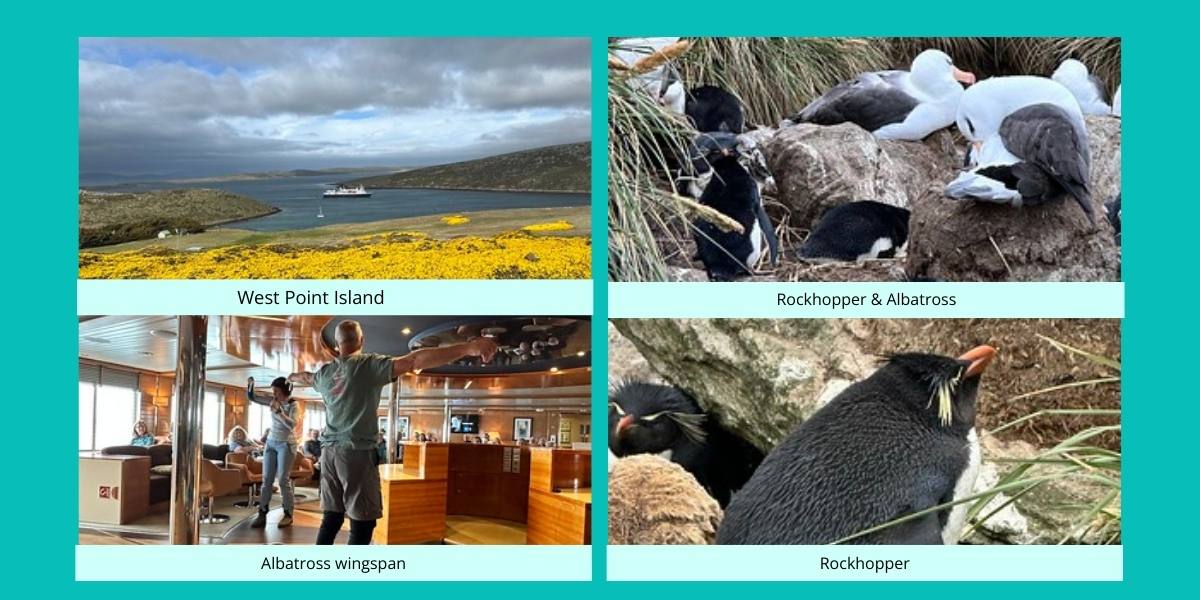
West Point Island has only two human residents, Kicki Ericson and Thies Matzen, a kind couple who had tea and treats waiting for us at their home. West Point is a treasured stop for the Lindblad/Nat Geo family, as Lars-Eric Lindblad, a pioneer in expedition travel, has some of his ashes spread here.
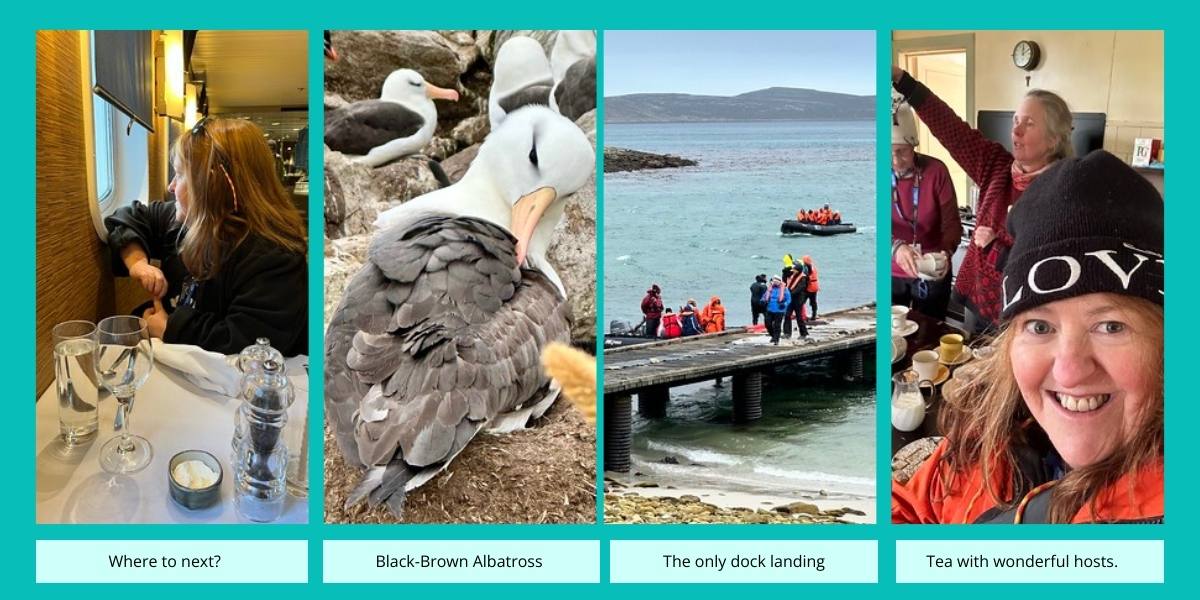
Wildlife spotting (12th): rockhopper penguins, albatross
November 13 (Day 7): Hello Stanley Island!
Welcome to Stanley, the capital of the Falkland Islands! This was our only dry landing, and I greatly appreciated it. Navigating out of the Zodiacs with waves and wind is tricky, though the staff is always there to help.
There were a few options, and Red and I chose to tour the Fitzroy Family Farm, a holistically managed sheep farm with nearly 20,000 sheep. We witnessed sheep shearing and watched the dogs herd them. We also saw miniature horses, chickens, pigs, and the cutest lambs. Gilberto Castro and Suzi Clark run the farm and were incredibly welcoming. We had tea at their house before heading back to the ship.
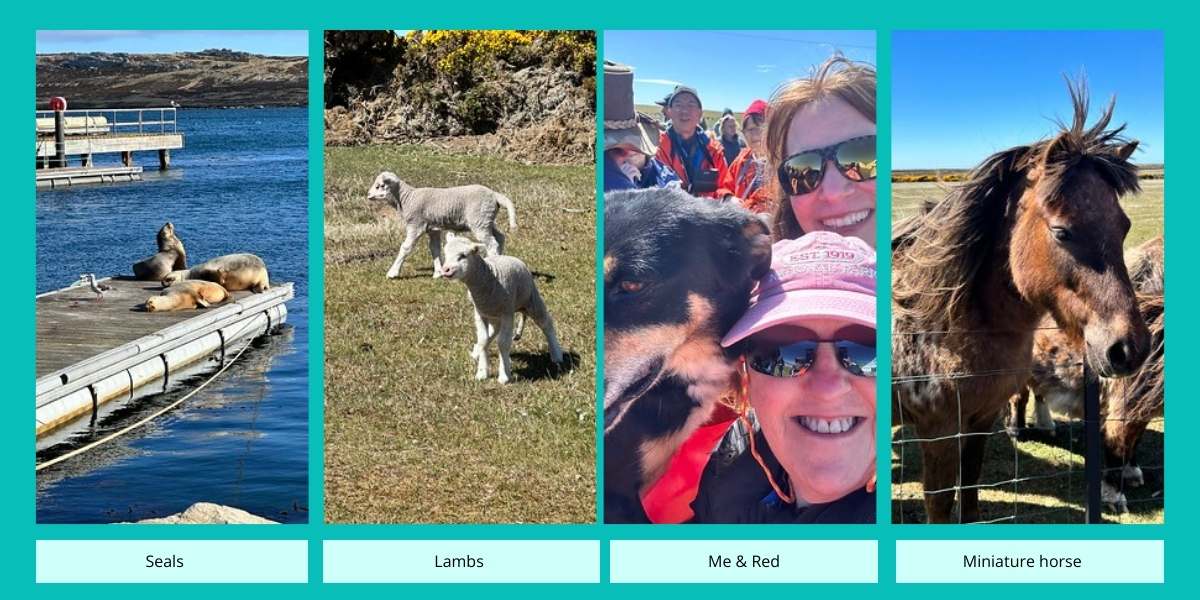
Back on board, we set sail for 2 ½ days at sea. While the rest of our journey would mostly be in daylight, we enjoyed seeing the majestic Milky Way and the Southern Cross tonight. If you know me, you know I’m a star gazer. Oh, my stars!
Wildlife spottings (13th): fur seals, sheep, dogs, chickens, pigs, miniature horses. Ok, some were not wild, but I still spotted them. 🙂
November 14 (Day 8): A Day at Sea.
We spent a full day at sea heading toward South Georgia. During sea days, the staff experts and photographers offer sessions in the lobby on various topics: birds, mammals, plant life, geography, and ice. They share their vast knowledge and support each other during the talks.
We also received some upsetting news. The bird flu, H5N1, had reached the South Georgia Islands and wreaked havoc. Some landings had already been closed, leaving us wondering what we would see and whether we could land. It’s believed that birds flying over from Argentina, already hit by the flu, brought it to the islands, killing most of the elephant seal pups. It was a stark reality, but as a scientific expedition, we knew it was important to forge ahead. We received information from ships ahead of us, relaying updates on landings, with 14 currently closed. The staff did a beautiful job explaining the effects of global warming without a doom-and-gloom perspective.
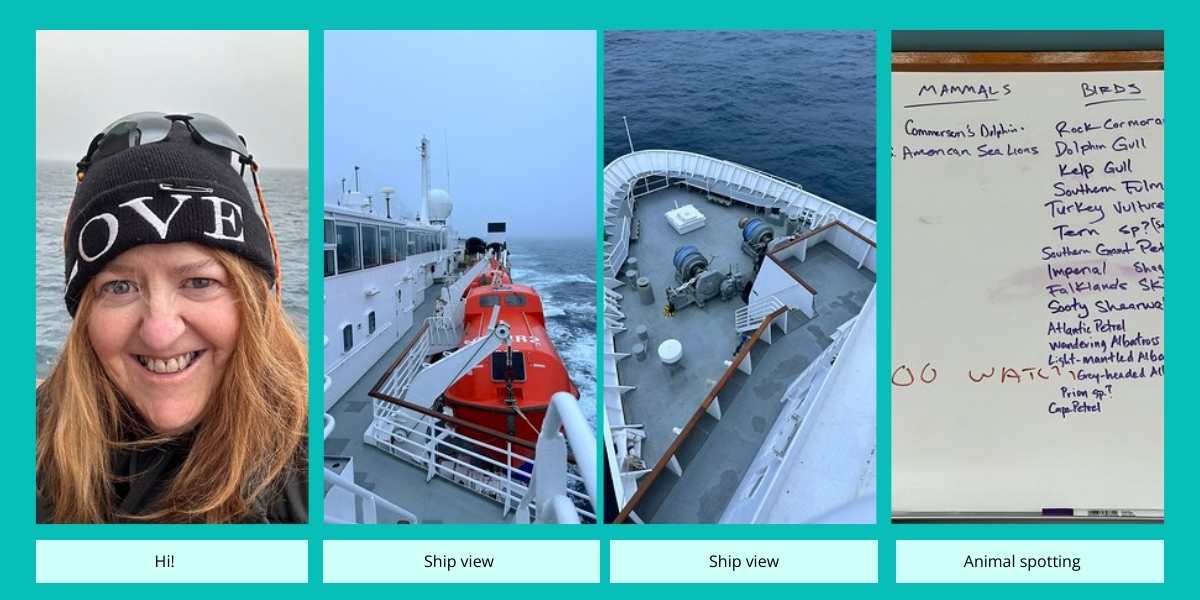
Wildlife spotting (14th): light-mantled albatross, royal albatross, sooty albatross, wandering albatross.
November 15 (Day 9): The Sea and The Ice!
We continued our journey across the Patagonian Shelf toward South Georgia and crossed the Antarctic Convergence. The only way to tell you’ve crossed the convergence is a sudden drop in water temperature, going from cold water to COLD water, and the appearance of ice. We spent the day listening to fascinating talks about Shackleton and the glaciers. Seeing icebergs this early was unusual, as they typically appear after South Georgia and before Antarctica.
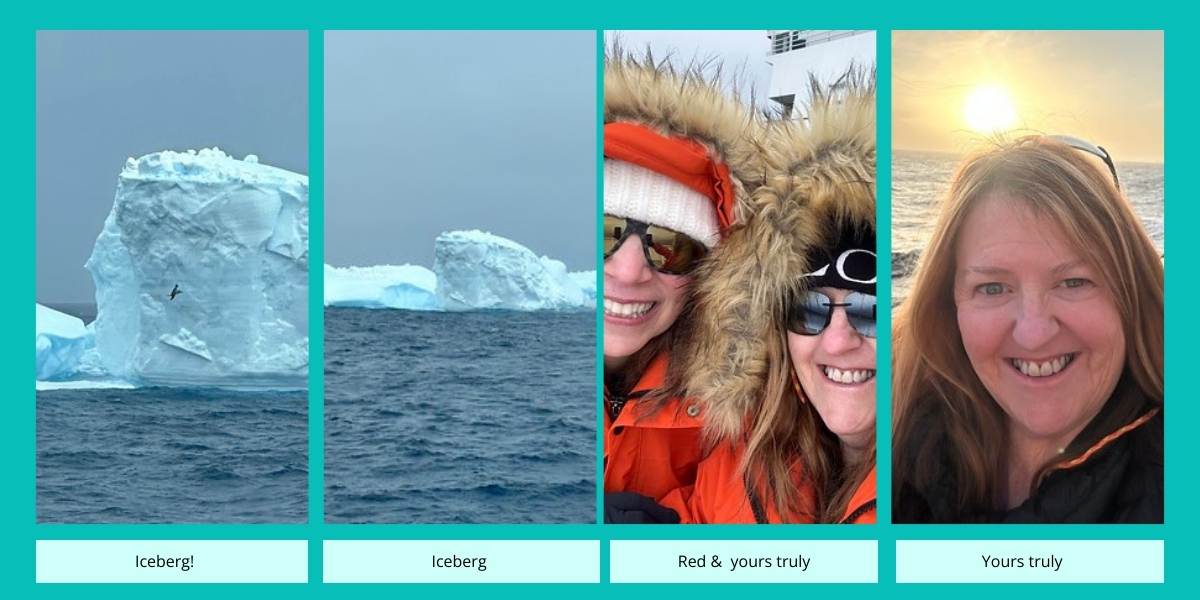
In the morning, we were called down to the mudroom in groups to clean our outer gear and ensure we didn’t take anything ashore that didn’t belong there. They are cautious about cross-contamination, making the cleaning process interesting and tedious. They inspected me closely, and I had to scrub my boots again. They literally looked for the smallest speck in order to keep the area pristine.
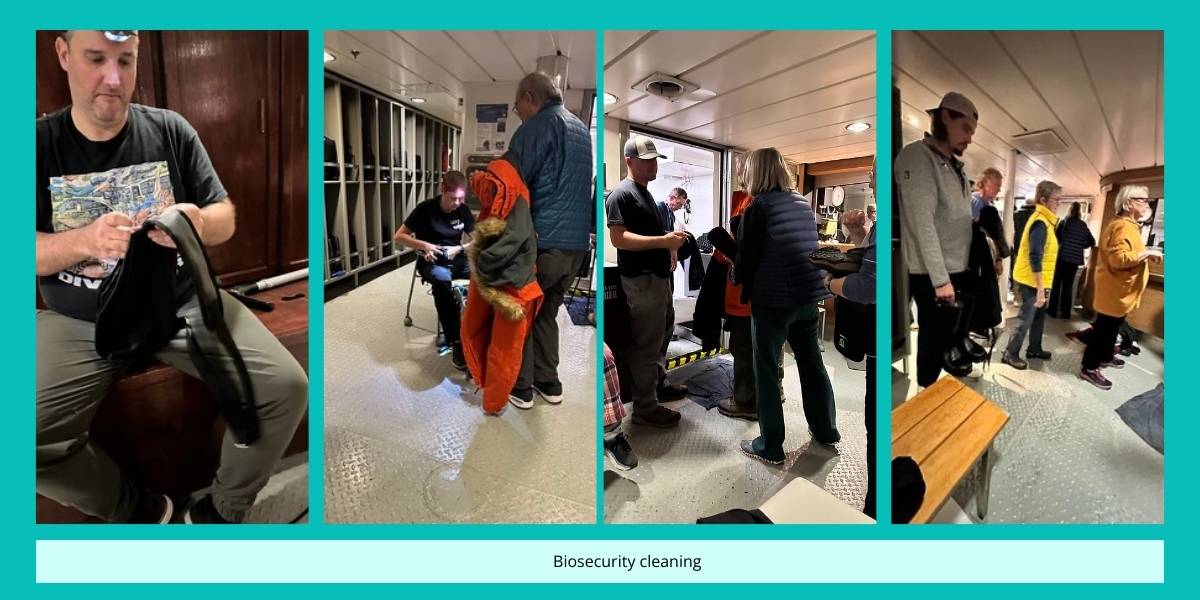
November 16 (Day 10): Hello, Pegotty, South Georgia
Today was bitterly cold, with temperatures plunging to 38 degrees and sleet driven sideways by strong winds. The weather throughout most of the trip felt like a typical Chicago winter, ranging between 25 and 40 degrees. In South Georgia we were greeted with fog, wind, rain, sleet, and snow. Since it’s their spring, I was much better prepared for this weather here than I usually am back in Chicago.
Before we disembarked, the crew checked for any signs of bird flu, and thankfully, this location was clear. We could choose between long, medium, or short hikes. I took the short hike to stay close to the shore and immerse myself in the wildlife. Being so close to the seals and penguins is indescribable. They genuinely don’t care about us, although the male fur seals can get territorial, reminding you that you are in their world.
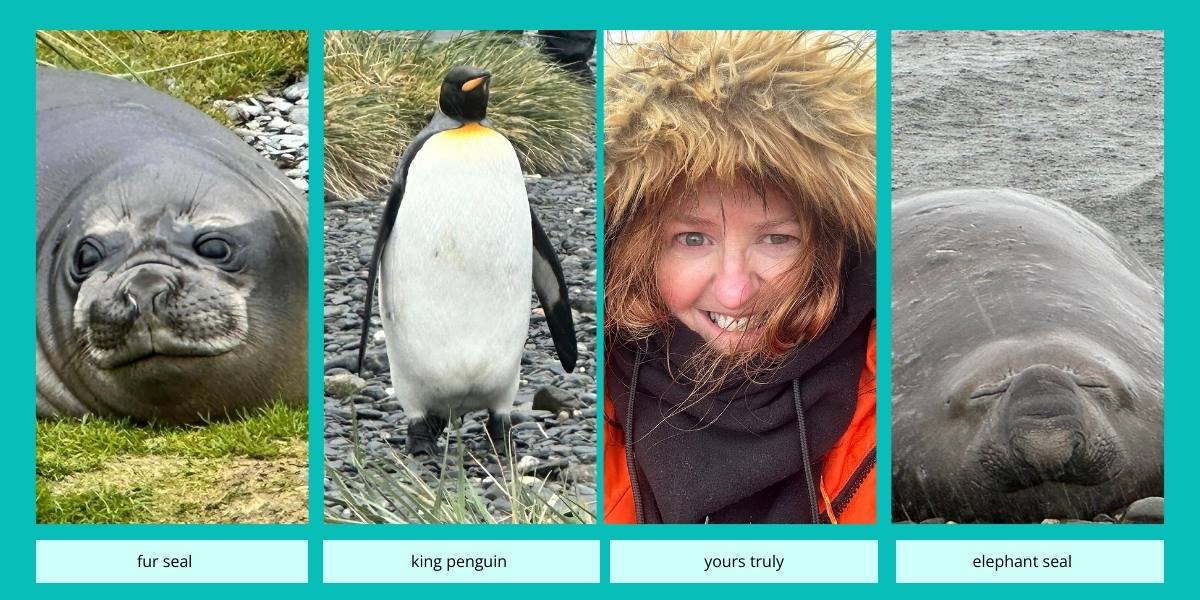
Today, I also had to say goodbye to my beloved LOVE hat. A gust of wind snatched it out of my reach in a split second. I was genuinely saddened to lose it, as I was deeply attached to that hat. I picked up another hat in the gift shop, and when I returned to Chicago, I was touched to find that two friends and my sister had ordered new LOVE hats for me. Their thoughtfulness was incredibly moving. Interestingly, the moment was captured on video. While I was out enjoying the wind and struggling to stay upright, a friend on the bridge filmed it. The wind was so strong that it even untied my shoelaces. The windy city has nothing on this place!
While I did cry over the loss of my hat, the region’s immense beauty far outweighed my tears of joy and gratitude.
Wildlife spotting (16th): king penguins, elephant & fur seals
November 17 (Day 11): Fortuna Bay, South Georgia Island
We anchored in Fortuna Bay and spent the day there. Although we couldn’t visit the Stromness Whaling Station due to the H5N1 bird flu, what we did experience was magical. Thousands of King Penguins surrounded us, including last year’s chicks, the fluffy brown ones known as the Oakum Boys. Their parents were out at sea, gathering food to return to them.
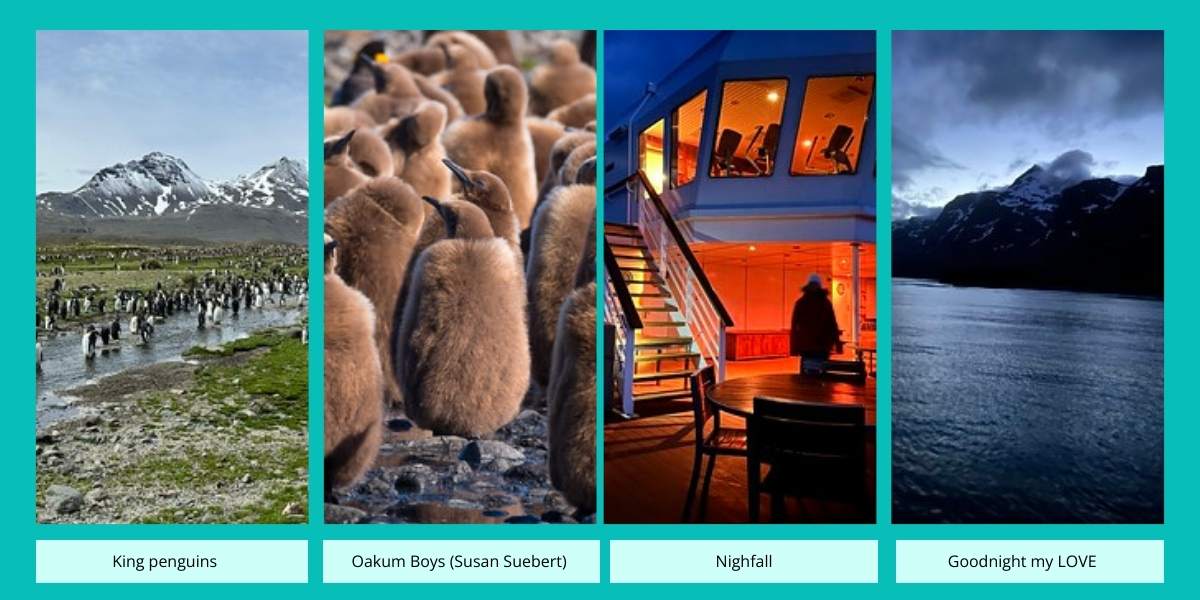
Wildlife spotting (17th): king penguins, elephant & fur seals
November 18 (Day 12): Stromness & Hercules Bay
Another day in paradise! We were in Hercules Bay and had the opportunity to kayak and take a Zodiac ride along the ice. Although I enjoy kayaking, my experience has only been on relatively calm lakes. Kayaking on the ocean, even if in a bay, was a whole new adventure. Being so close to the water was terrific, but maneuvering the kayak was challenging. I preferred the Zodiac rides, where I could fully take in the surroundings while someone else did the steering. In the afternoon, we cruised along Stromness Bay as we couldn’t land due to the bird flu.
The crew, Amy and Sean, demonstrated how the penguins can identify the sound of their chicks among the hundreds around them. They engaged us in a fun activity: the male travelers were instructed to shout, “Get off my beach,” while the female travelers yelled, “I’m over here.” It was a fun and educational moment, adding to the information we received about the area and its wildlife. Check out the video below.
Wildlife spotting (18th): cormorants, macaroni, gentoo, & king penguins, elephant & fur seals
November 19 (Day 13): Grytviken
Snow! Today, we explored Grytviken, a former whaling station that closed in 1965. South Georgia has no permanent residents, but seasonal scientists come here for research. We toured the museum and visited the burial site of Ernest Shackleton. Shackleton’s grave is uniquely oriented south towards Antarctica, unlike the other graves, which point east. Elise, one of our naturalists, noted that the graves seem to be sinking compared to her last visit. We had planned to do a shot to honor ‘the Boss,’ Shackleton, but we toasted him back on the ship that evening.
Due to numerous closures caused by the bird flu, our itinerary changed, and we headed to Drygalski Fjord. There, we witnessed a small iceberg calving—a truly unforgettable sight. I was amazed at how close the captain maneuvered the ship to the shore as if he had parked this massive vessel on the land.
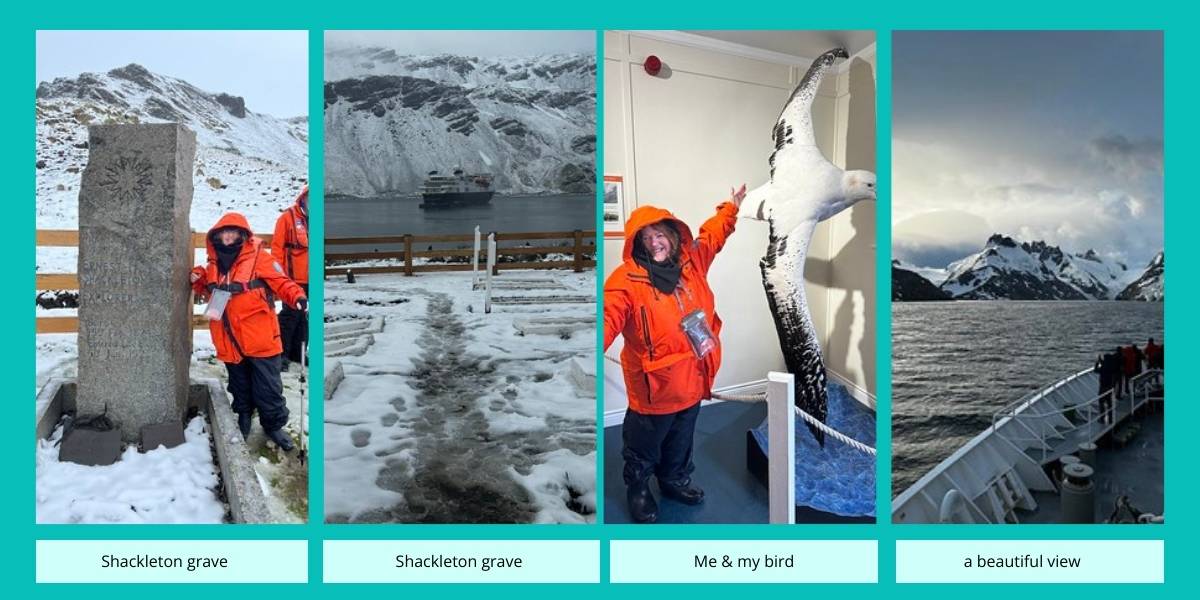
Wildlife spotting (19th): elephant & fur seals
November 20 (Day 14): Sea Day Heading to Antarctic
A day at sea as we made our way toward the Orkney Islands. The visibility was low, and snow fell steadily along our route, adding a touch of mystique to the journey. It felt like we were venturing into uncharted territory, places where few have ever gone. Along the way, we were graced with the presence of fin and humpback whales, making the experience even more magical.
Wildlife spotting (20th): fin & humpback whales
November 21 (Day 15): South Orkney Islands
As we journeyed toward the South Orkney Islands, We had the incredible privilege of spotting a Blue Whale—the largest animal on Earth, measuring up to 100 feet in length and weighing as much as 200 tons. Despite their massive size, these gentle giants are incredibly graceful as they glide through the ocean. Blue Whales are sadly on the endangered list, primarily due to hunting and environmental threats, making this encounter even more profound. Witnessing one in the wild was a moment of awe that left us speechless. Later, we took Zodiac rides around the islands, immersed in stunning landscapes teeming with abundant wildlife—from seabirds to seals and beyond. It felt like stepping into another world where nature’s beauty and majesty reign supreme.
Wildlife spotting (21st): cape petrels, snow petrels, southern fulmer, chinstrap penguins, weddell seals, leopard seal, blue whale
November 22 (Day 16): Weddell Sea and largest iceberg
Good morning! Baby, it’s cold outside—29 degrees with the wind blowing strong. We’re heading toward the largest iceberg in the world, and it’ll take us three hours just to pass it.
WOW, A23A did not disappoint! It’s hard to believe it’s an iceberg and not an island—it’s that massive. A23A last held the title in January 2021, and unlike most giant icebergs that drift away from Antarctica, this one has barely moved since it broke off the Filchner Ice Shelf in August 1986. It’s grounded on the sea floor, making it less likely to fragment or drift. It’s estimated to rise about 90 feet above the water and extend roughly 400 feet below. To put its size in perspective, A23A measures 40 by 34 nautical miles, covering more than 1,540 square miles—larger than Rhode Island’s 1,214 square miles. Trust me, the pictures do not do it justice.
And if that wasn’t enough, we spotted at least 16 orcas by the iceberg, adding to the surreal beauty of the day. The experience of our ship cutting through the ice was something else entirely—the crew handled it with precision and care, making the moment even more magical. I’ve genuinely run out of words to capture it all.
Wildlife spotting (22nd): adelie penguins, orca whales
November 23 (Day 17): Thanksgiving
Happy Thanksgiving from Paulet Island! Every day here feels like a pinch-me moment—‘Is this real?’ And the answer is YES, it is. We started with a Zodiac ride through the ice and a hike among the Adelie penguins. It’s estimated there are about 100,000 breeding pairs here. We’re supposed to stay 5 meters (16 feet) away from them, but the penguins didn’t get the memo—they walked right up to us! You could easily touch one if it were allowed (which it’s not). Of course, I behaved and resisted the urge to hug them, even though I wanted to. 🙂
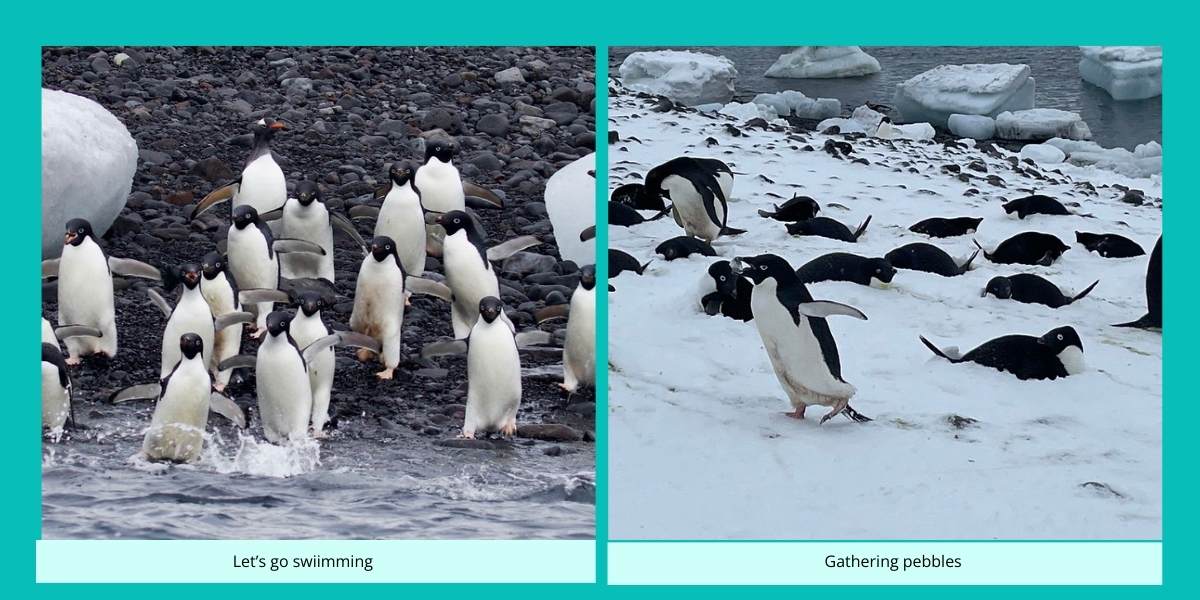
We received a Thanksgiving gift on board and under sail—spotting Emperor Penguins on the ice! Despite the cold, everyone was out there snapping photos and marveling at these majestic birds, the largest of which stand up to 4 feet tall and over 50 pounds!
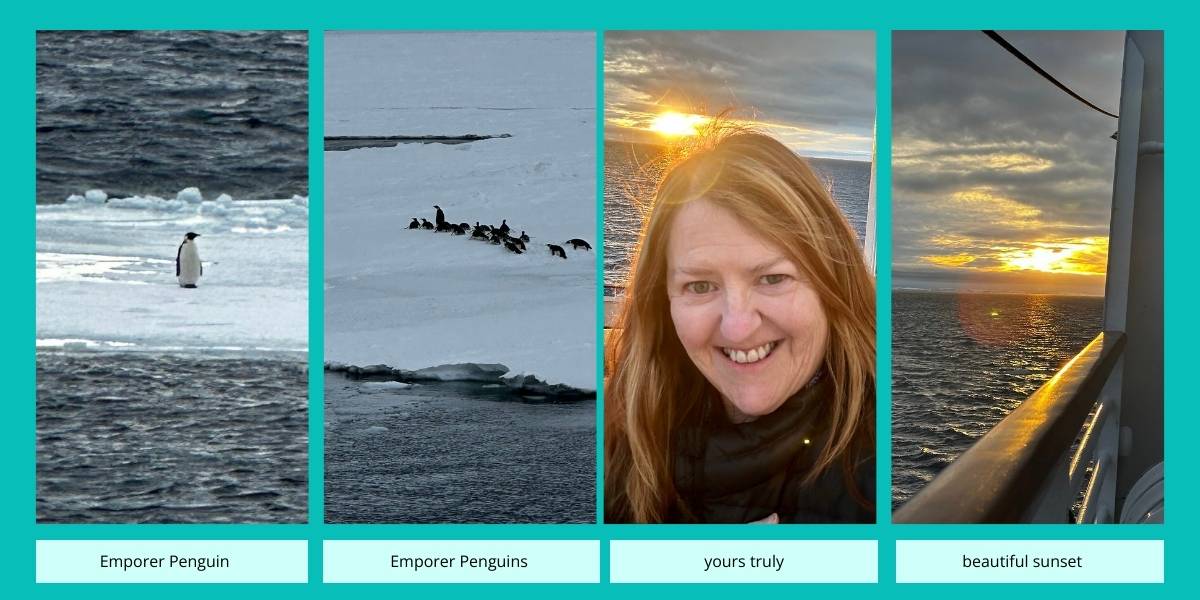
Dinner was a fantastic traditional Thanksgiving feast. From meal prep to service, everything was done beautifully. What a day—one to be truly thankful for! It was my first Thanksgiving away from family, and I sure did miss them!
Wildlife spotting (23rd): adelie & emporer penguins, skua
November 24 (Day 18): Brown Bluff & Hugs!
Day 18 of this incredible journey is one for the record books! We set foot on ANTARCTICA today. Words can’t capture the feeling of stepping onto the seventh continent at Brown Bluff—it was beyond exceptional. Hundreds of penguins surrounded us, and while the icebergs and wildlife were breathtaking, the entire trip’s highlight was offering FREE HUGS on Antarctica.
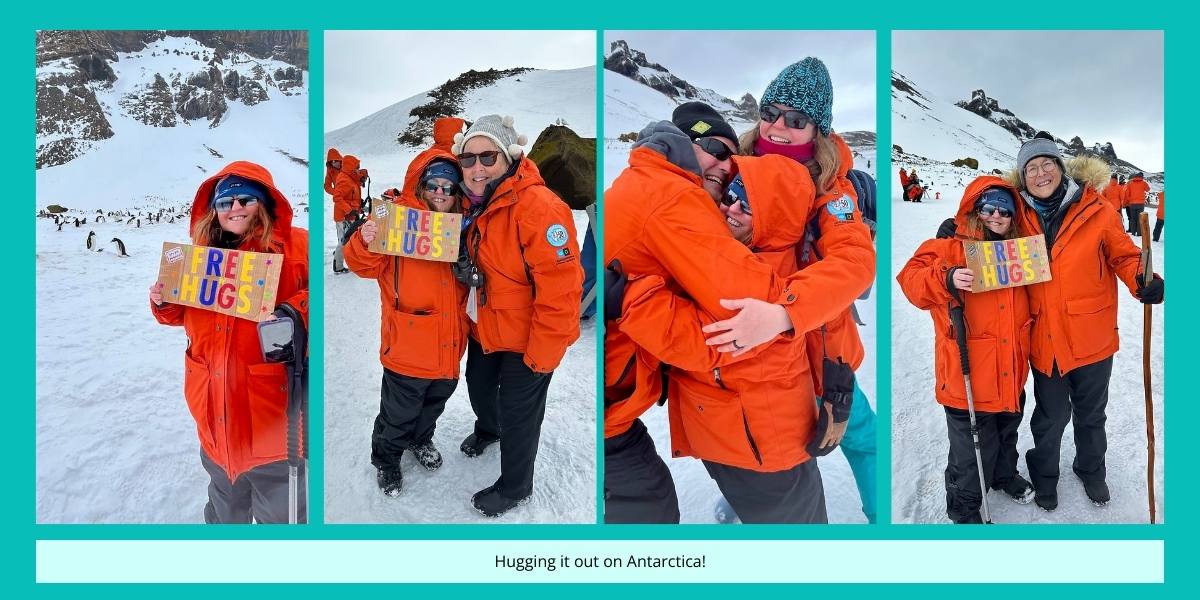
Since the inception of Global Free Hugs, it’s been a dream of mine to bring hugs to all seven continents. With huggers already on the other six, Antarctica was the final frontier. I had invited others to join me over the years, but it seemed like a long shot with no takers or permanent residents. But today, that dream came true. The enthusiasm of fellow explorers and staff who joined me in the effort made it even more special. Their support meant the world to me.
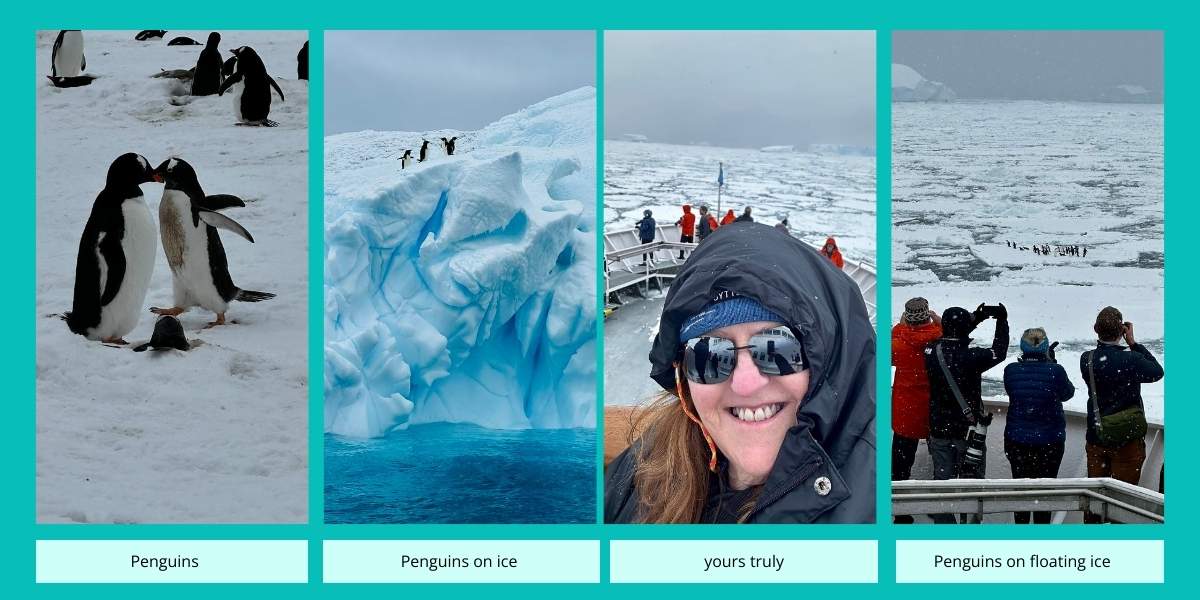
Fun fact: Just a few days after we left the A23A, the world’s largest iceberg, it broke loose and began its journey again. I’m convinced it wanted to tag along with me! Take a look at this article and video.
Wildlife spotting (24th): adelie & gentoo penguins, Antarctic shags
November 25 (Day 19): Cierva Cove
Oh, what a day! It kicked off with orca sightings while we were still on the ship—an instant thrill since orcas are my favorite. With snow and too many seals at Mikelsson Harbor, we pivoted to Cierva Cove, where blue skies, glassy waters, towering glaciers, and massive icebergs welcomed us. We hopped into Zodiacs to soak in the breathtaking scenery and came across a small island teeming with nesting Gentoo, Adelie, and Chinstrap penguins. And the excitement didn’t stop there—we spotted humpback whales so close to our Zodiac, it was surreal! We even saw a leopard seal lounging peacefully on an iceberg.
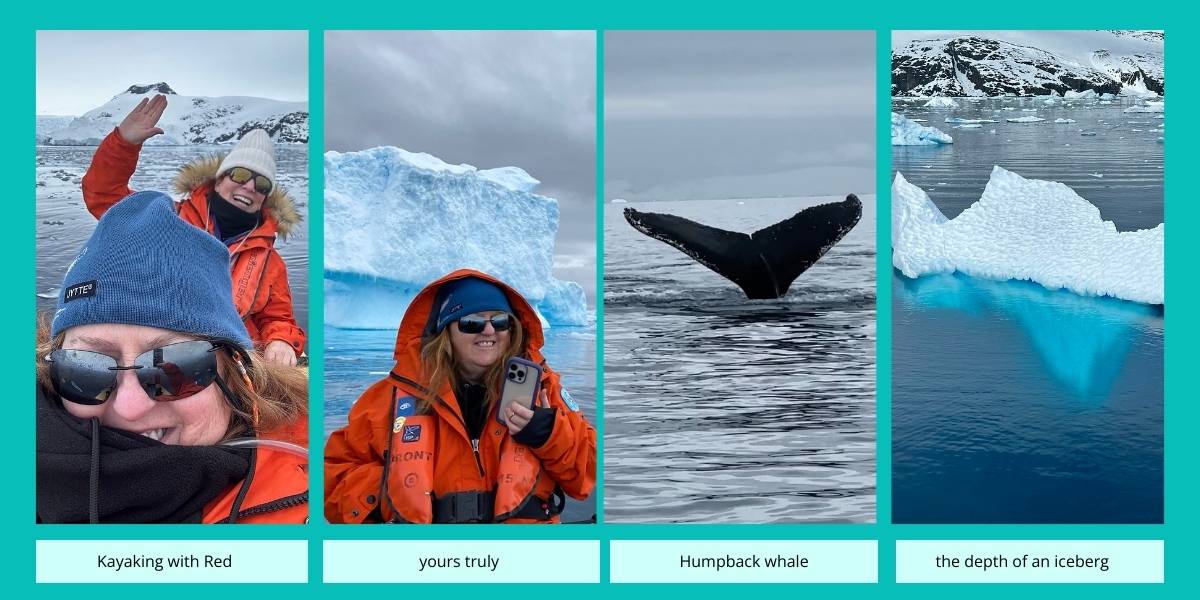
Later in the afternoon, I had the chance to kayak again, but it didn’t go as planned. I quickly got my gloves soaked, and by the time I made it back aboard, I was so numb I could hardly get out of the kayak. I felt awful and wrapped myself in blankets back in the cabin, sleeping for about 90 minutes before feeling better. That was also the day of the Arctic plunge, which I was already unsure about, but after the kayaking experience, I was more than happy to cheer from the sidelines.
That evening, the kitchen crew, many from the Philippines, treated us to a beautiful meal. The night ended with their band playing in the lounge. Everyone danced and had a fantastic time.
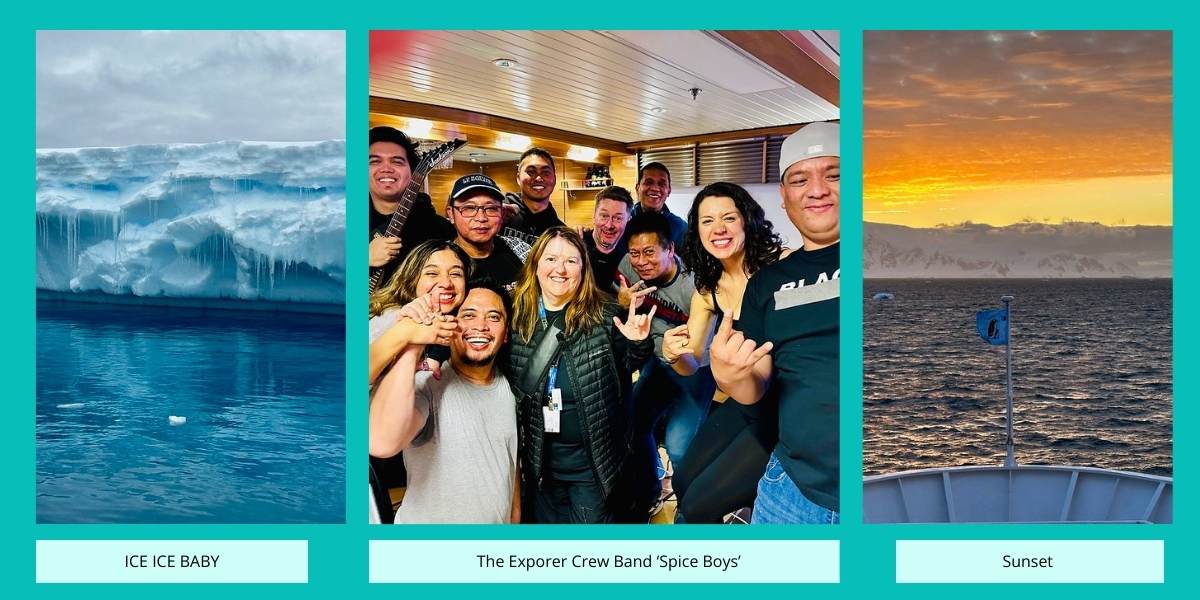
Wildlife spotting (25th): adelie, chinstrap & gentoo penguins, leopard seal, humpback & orca whales
November 26 (Day 20): Petermann Island
Our last day in Antarctica, and I’m not ready for it to end—but what an adventure it has been. We began with an early wake-up call from the expedition leader, and everyone bundled up to head outside for our transit through the Lemaire Channel. This narrow passage, framed by towering snow-capped mountains, is one of the most breathtaking spots in Antarctica.
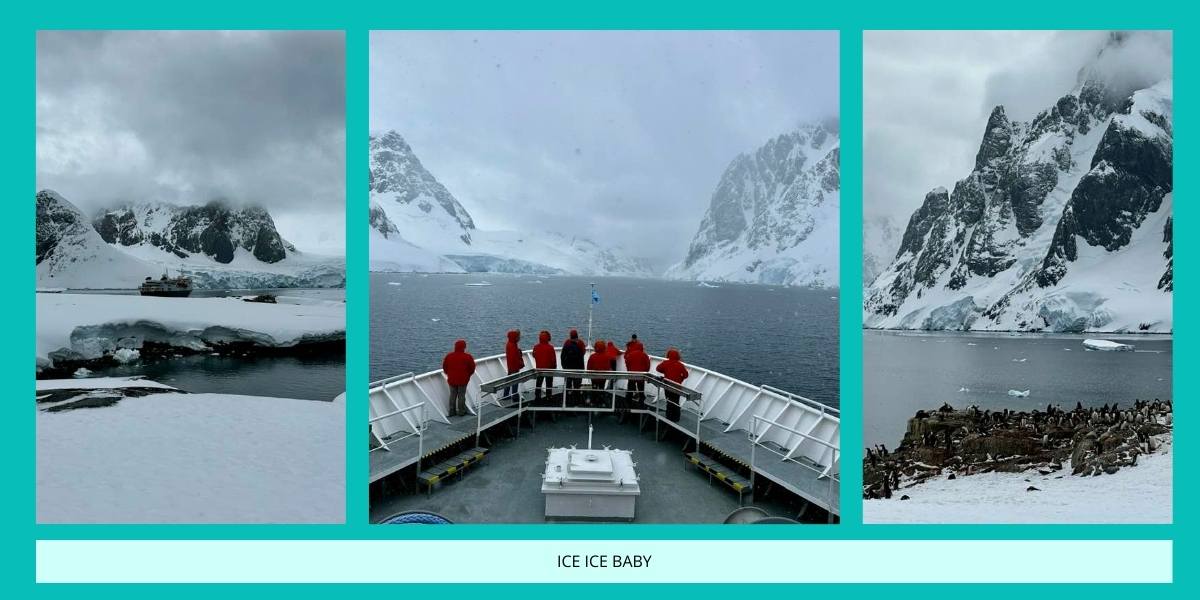
Thanks to the skillful bridge team, we safely navigated through the channel and enjoyed breakfast as we arrived at Petermann Island, located in the northwest corner of the Kyiv Peninsula. It was our final hike on Antarctica and our last Zodiac ride. We also had one last chance to be amongst the penguins, soaking in their charm for the final time.
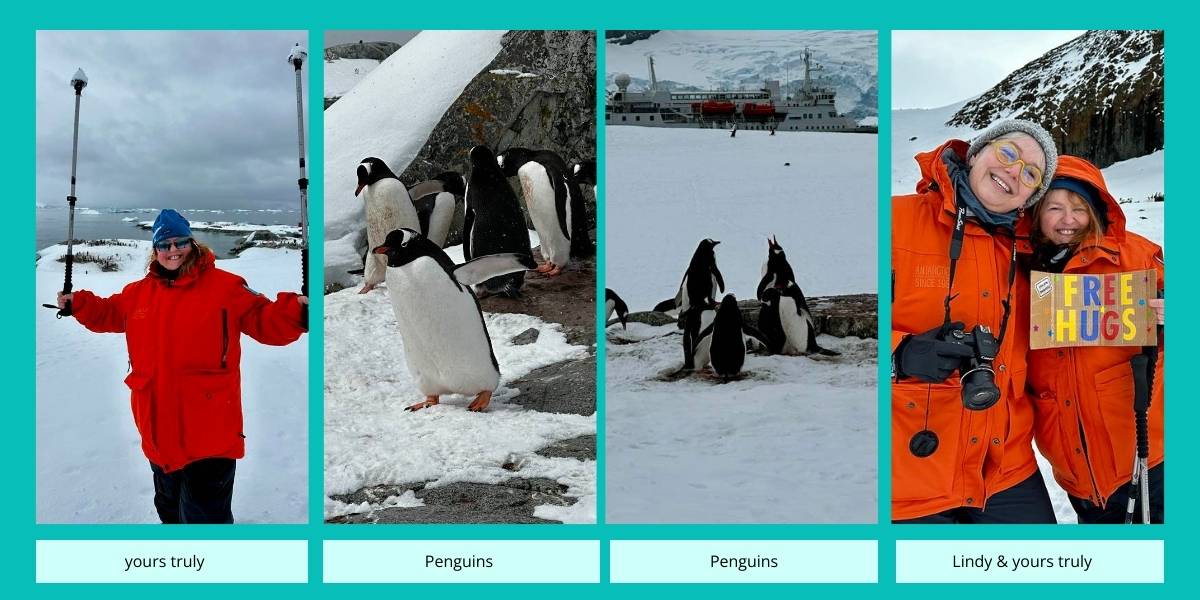
Wildlife spotting (26th): adelie & gentoo penguins
November 27 (Day 21): Drake Passage Heading Home
Good morning from the Drake Passage! The waves are decent-sized but manageable, though many have been battling seasickness.
Living on a boat for nearly three weeks has been an extraordinary experience! I’ll genuinely miss being rocked to sleep each night.
The Drake Passage is renowned for being one of the most treacherous routes for ships. With currents meeting no landmass resistance and waves reaching up to 40 feet (12 meters), it truly lives up to its reputation as “the most powerful convergence of seas.”
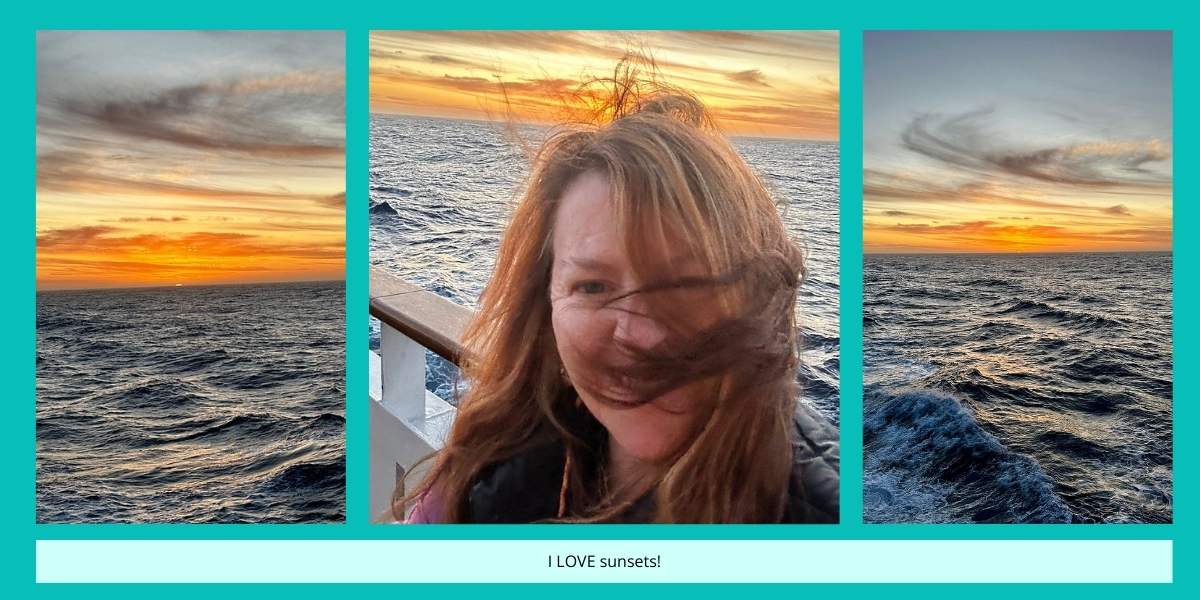
November 28 (Day 22): Day at Sea & Hello Ushuaia
We needed an Argentinian pilot onboard as we sailed back to Ushuaia through the Beagle Channel. On the way out, this happened around 11 pm, and I saw it from my window. I had no idea what was happening at first, but then a boat pulled up alongside us, and a man jumped on board before the ship pulled away. The sight of this ‘pirate’ (lol) boarding the boat enthralled me so much that I didn’t get a picture. Thankfully, on the way back, I was able to capture the ‘pirate’ landing.
While in Antarctica, my sailing sister Emily was in the Arctic. She asked me to help make a “world sandwich” without knowing we were both on these trips.
From Emily: “I asked my sailing sister Carol C C Miller to help me make a world sandwich. I’m in Tromsø, above the Arctic Circle, possibly the farthest north I’ll ever be. Carol is in Antarctica at the same time! Here is our version of an earth sandwich.” Check out the pictures of our world sandwich!
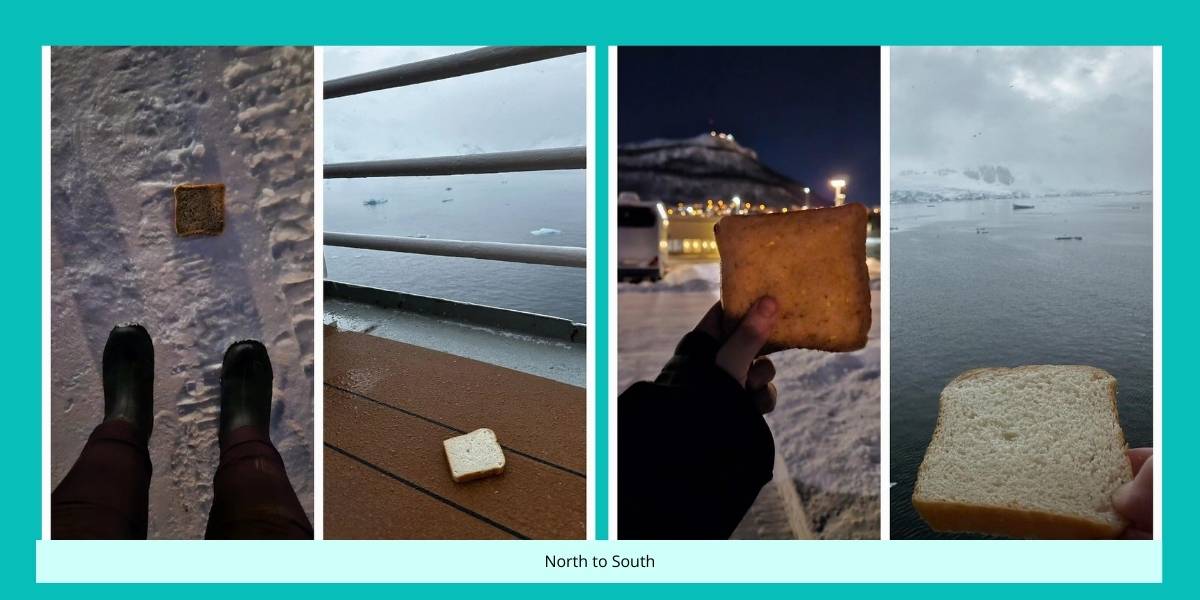
Jen, a 3rd-grade teacher from Baltimore, created flat figures of her 17 students, each participating in daily activities. I had the pleasure of taking these flat kids on a ship tour, and the kids and I had a great time.
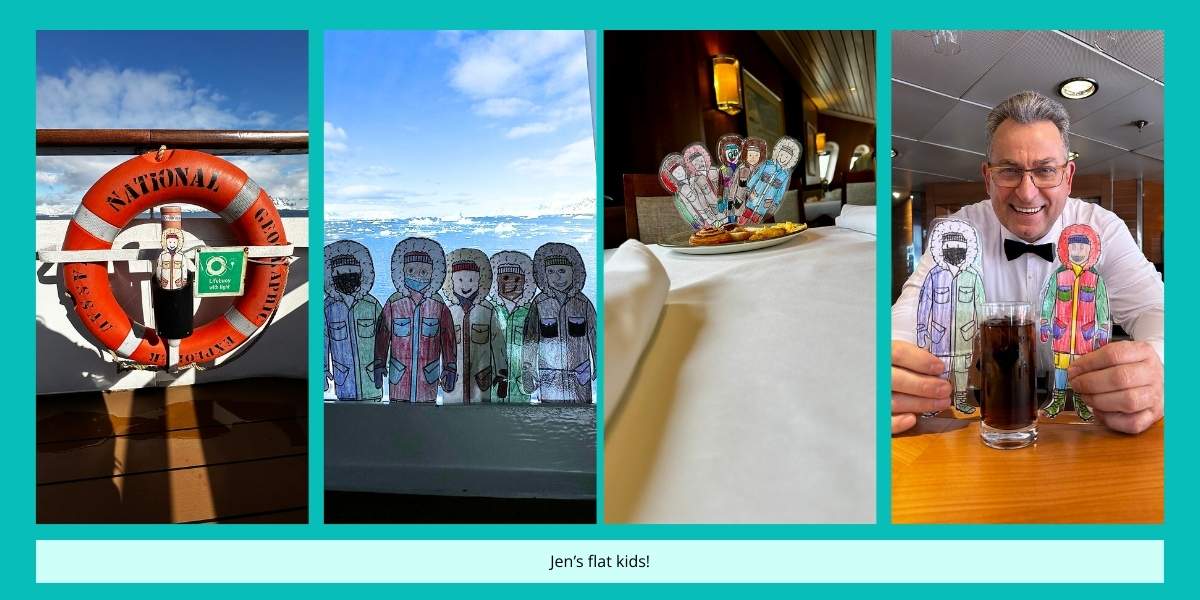
I hoped to stay under the radar for my birthday, which fell on disembarking day, but I was mistaken. The crew surprised me with three songs, and despite my efforts, I couldn’t help but feel moved. Although I typically shy away from being the center of attention, this gesture was incredibly touching, and of course, I hugged them all. The crew excelled in their roles, making everyone feel at home throughout the voyage. Check out the video of them singing to me.
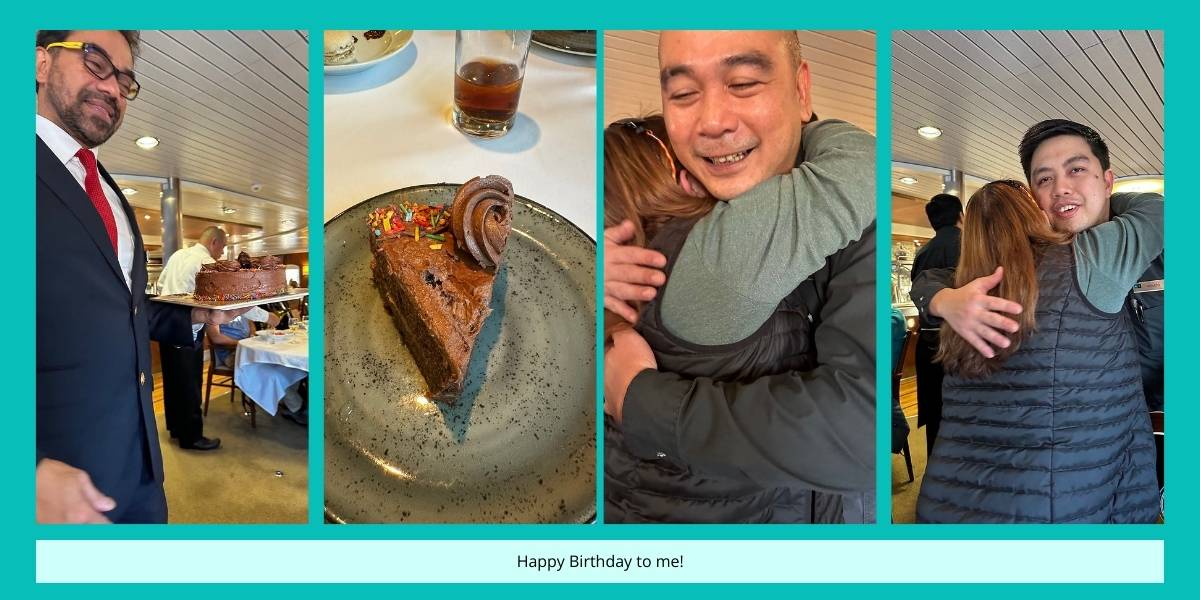
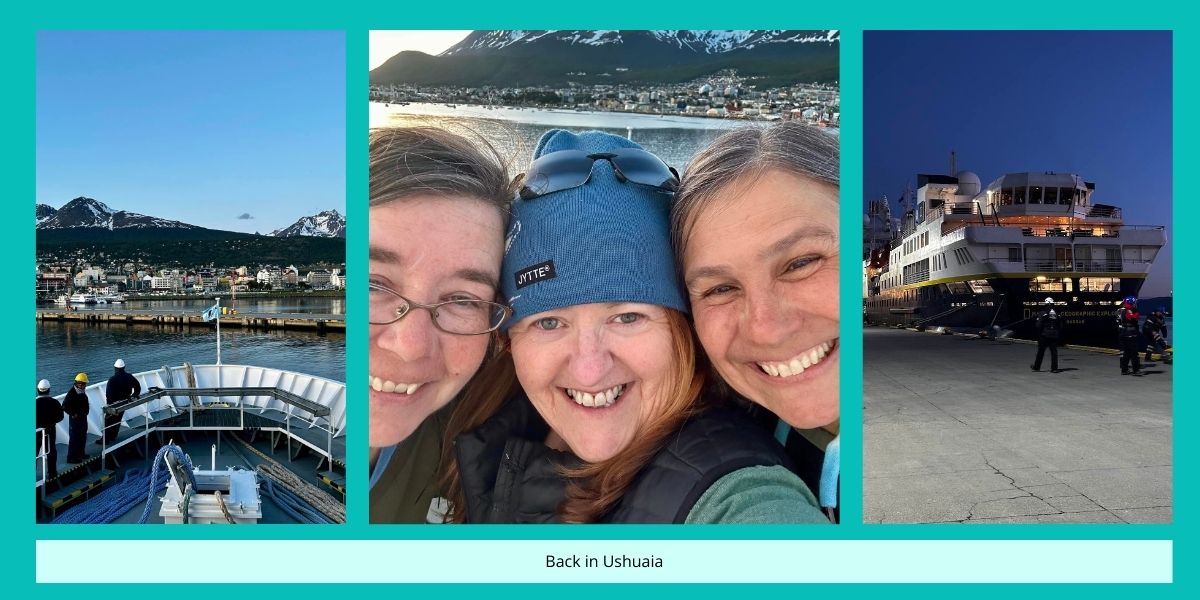
November 29 (Day 23): The journey home.
So long, for now, my LOVE. I am forever changed.
As I embark on my 24-hour journey home, I will let the last three weeks soak in and become part of my DNA. The people I’ve met and the places I’ve seen have all left an indelible mark on me. While beauty surrounded us, we also witnessed the devastating impact of the bird flu in South Georgia. Even though we saw only a tiny portion of it, the staggering loss of birds and seals was heartbreaking.
The region, the people I shared the experience with, and the wildlife will live in my heart forever.
Hugging Penguins
Many people asked that I hug penguins. I tried to oblige. 🙂
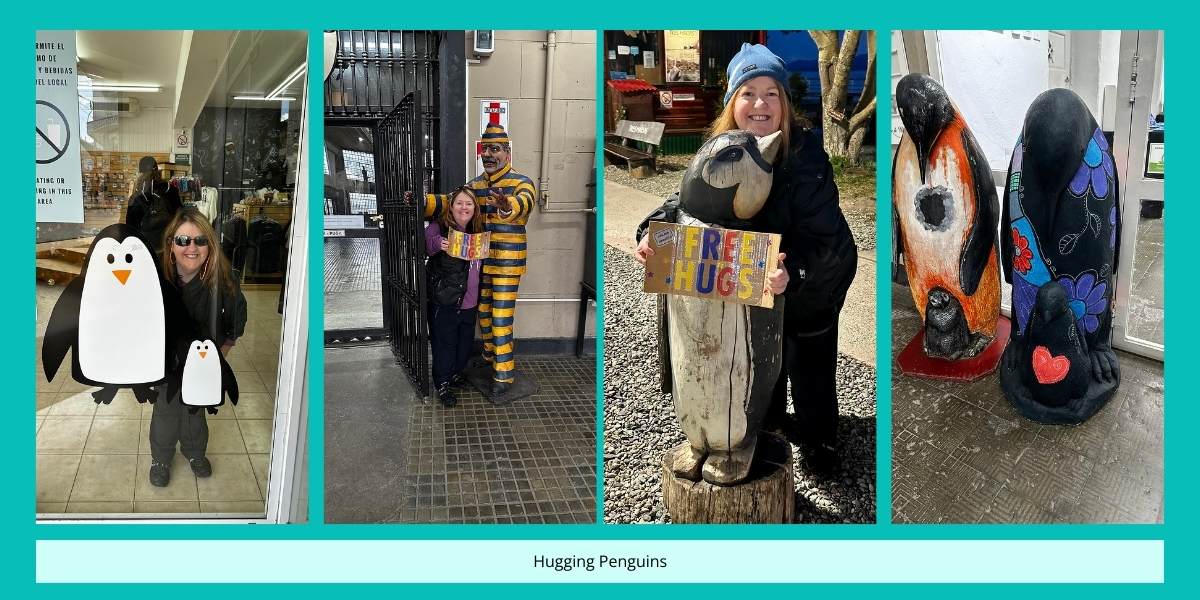
Epilogue
This trip was magical on so many fronts—a bucket list dream I never imagined would come true, yet it did. Whatever your dreams are, even if you can’t see how they can happen, know they are worthy. Write down what you want to experience, and take that first small step toward your dream. Be kind and gentle as you navigate life, allowing things to work out better than you imagine. Your dream is taking steps toward you, too.
Antarctica, until we meet again, you live in my heart. I LOVED you then, I LOVE you now. I will LOVE you forever.



